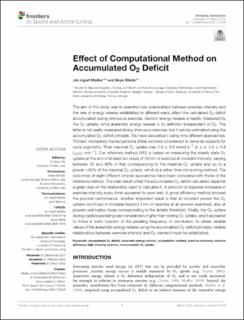| dc.contributor.author | Medbø, Jon Ingulf | |
| dc.contributor.author | Welde, Boye | |
| dc.date.accessioned | 2022-06-02T08:16:35Z | |
| dc.date.available | 2022-06-02T08:16:35Z | |
| dc.date.created | 2022-02-16T12:43:06Z | |
| dc.date.issued | 2022 | |
| dc.identifier.citation | Medbø, J. I., & Welde, B. (2022). Effect of computational method on accumulated O2 deficit. Frontiers in Sports and Active Living, 4. | en_US |
| dc.identifier.issn | 2624-9367 | |
| dc.identifier.uri | https://hdl.handle.net/11250/2997326 | |
| dc.description.abstract | The aim of this study was to examine how relationships between exercise intensity and the rate of energy release established in different ways, affect the calculated O2 deficit accumulated during strenuous exercise. Aerobic energy release is readily measured by the O2 uptake, while anaerobic energy release is by definition independent of O2. The latter is not easily measured during strenuous exercise, but it can be estimated using the accumulated O2 deficit principle. We have calculated it using nine different approaches. Thirteen moderately trained persons (three women) volunteered to serve as subjects for cycle ergometry. Their maximal O2 uptake was 2.9 ± 0.6 mmol s−1 (x̄ ± s; 3.9 ± 0.8 LSTPD min−1). Our reference method (M0) is based on measuring the steady state O2 uptake at the end of at least ten bouts of 10 min of exercise at constant intensity, varying between 30 and 40% of that corresponding to the maximal O2 uptake and up to a power >90% of the maximal O2 uptake, which is a rather time-consuming method. The outcomes of eight different simpler approaches have been compared with those of the reference method. The main result is that the accumulated O2 deficit calculated depends a great deal on the relationship used to calculate it. A protocol of stepwise increases in exercise intensity every 4 min appeared to work well. A gross efficiency method showed the poorest performance. Another important result is that at constant power the O2 uptake continued to increase beyond 4 min of exercise at all powers examined, also at powers well-below those corresponding to the lactate threshold. Finally, the O2 uptake during loadless pedaling was considerably higher than resting O2 uptake, and it appeared to follow a cubic function of the pedaling frequency. In conclusion, to obtain reliable values of the anaerobic energy release using the accumulated O2 deficit principle, reliable relationships between exercise intensity and O2 demand must be established. | en_US |
| dc.language.iso | eng | en_US |
| dc.publisher | Frontiers Media S.A. | en_US |
| dc.rights | Navngivelse 4.0 Internasjonal | * |
| dc.rights.uri | http://creativecommons.org/licenses/by/4.0/deed.no | * |
| dc.subject | accumulated O2 deficit | en_US |
| dc.subject | anaerobic energy release | en_US |
| dc.subject | computation method | en_US |
| dc.subject | exercise economy | en_US |
| dc.subject | exercise efficiency | en_US |
| dc.subject | high-intensity exercise | en_US |
| dc.subject | measurement | en_US |
| dc.subject | O2 uptake | en_US |
| dc.title | Effect of Computational Method on Accumulated O<inf>2</inf> Deficit | en_US |
| dc.type | Peer reviewed | en_US |
| dc.type | Journal article | en_US |
| dc.description.version | publishedVersion | en_US |
| dc.rights.holder | © 2022 Medbø and Welde | en_US |
| dc.source.pagenumber | 1-14 | en_US |
| dc.source.volume | 4 | en_US |
| dc.source.journal | Frontiers in Sports and Active Living | en_US |
| dc.identifier.doi | 10.3389/fspor.2022.772049 | |
| dc.identifier.cristin | 2002326 | |
| cristin.ispublished | false | |
| cristin.fulltext | original | |
| cristin.qualitycode | 1 | |

